Yes, we went. Yes, they kill the bulls, four of them to be exact. But the meat is donated to charity. So there’s that. If it makes you feel better. While I felt sad for the bulls, my desire to witness such a cultural spectacle was outweighed by any squeamishness. Like it or not, this IS part of the culture of Mexico, just as is the cruel pastime of cock-fighting. Our aim is not to judge the practice, just to observe. And I was curious…what IS this all about?
The bullfight is a tradition still widely popular throughout Mexico (and Spain, Portugal, France and Argentina), yet this Spanish-originated pastime is slowly trending toward decline. Our particular bullfighting event is now held just once a year here in Mazatlan. We just so happened to be in town at the right time and lucked into getting tickets to this “Teatro del Toro”. Well, luck wasn’t everything…persistence is key.
Tracking Down Tickets
Online tickets? Puleease. And no box office. In fact, I could find zero info online as to how to go about getting seats or even just finding the event date. Luckily for us, we had the inside scoop from our friends who had gone years ago (shout out to Cuba Libre). The Teatro del Toro, or Theater of the Bulls, sells seats at the former oil change shop turned drive-in convenience store next to the arena. (Picture that… yes, you actually drive into the lift bay to peruse the crackers, candy and soda pops lined up along the bay walls. It’s strange, yet convenient… I don’t know why drive-through 7-11’s haven’t appeared in the US?)
Anyway, we ask the Saturday clerk when the bullfight is; Mr. Saturday knows nothing. Come back Monday, he says. OK. We come back on Monday. The Monday attendant is fortunately in the know. He says the fight is 2 weeks away, but tickets are not yet for sale. Come back next week. So we wait again. We are persistent. One week before the show, we return once more and buy tickets. The sign is finally posted on the outside of the arena: Teatro del Toro presents Pablo Hermoso de Mendoza… the famed bullfighting horseman!
Colosseum
Arriving inside the Colosseum-style arena is reminiscent of the classic ‘Roman gladiator vs. the lion’ setup. Concrete, tiered stadium seating surrounds a circular dirt field 360 degrees - not a bad seat in the house. The place is packed; I guess their simple, single-sign marketing campaign a week prior to show-time WAS brilliant – why advertise when you don’t have to? Standard snack fare: Tecate beer, cacahuates (peanuts), nacho chips with salsa poured right inside the bag (messy!) and chopped pieces of mystery meat (probably hot dogs). Don’t forget the tequila shots. A pep band pipes out peppy tunes to rouse the restless spectators.
Galloping Matador
After the matador introduction formalities, the first act begins. A handsome bullfighter rides out on horseback, introducing himself by galloping mightily around the arena, regaling the crowd. A galloping matador? Who ever heard of such a thing? Actually, “matador” isn’t the proper term; these matadors on horseback are called “rejoneadors”, translated directly as “lancers”. They are a much rarer breed of matador, and in my opinion, more fascinating due to their ‘horsey skilz’.
Pablo! Pablo! Pablo!
There are two horsemen at this show, but everyone comes to see Pablo Hermoso de Mendoza. The vivacious Spaniard is a world-renowned rejoneador, performing in Portugal, France, Spain, Mexico and South America for the past 26 years. Pablo was, in short, amazing to watch, as were his talented steeds. This audience was effortlessly swooned by his winning smiles and colonial gallantry, transporting us onlookers back in time. With a horse-pirouette here, a horse-curtsy there, and dozens of raised-arm “Huzzah!” moments, Pablo is a showman through and through. For more info on the dynamic Señor Hermoso, visit his website.
In the Lion’s Den
Pleasantries complete, the rejoneador awaits his encounter. The gate opens. But instead of a lion, a bull charges out into the impending war zone…and he is NOT happy. I don’t know what the heck they do back there to get him all riled up…but it can’t be pleasant. The bull hurtles at anything that moves, soon focusing his attention on the fastest object in the arena. The horseman gallops away, leading it ‘round and ‘round the ring.
Playing Tag
The horse and his human partner are as one entity: staring the beast down, challenging him to give chase. Now, I have zero authority as a “horse psychologist”, but I really believe the horse isn’t afraid of the bull. In fact, he appears to be having fun…like playing tag. “Ha ha, you can’t catch me!” They tease and provoke the bull, sidling up alongside, prancing and dancing about…leading the bull this way and that, often times with an elegant sidestepping motion. Amazingly, the horse twists and turns away at the last second before getting his hiney gored. After the first few minutes of cat and mouse, this first phase’s objective is complete: fatiguing the bull while displaying superior equestrian talent. The rejoneador exits to change his mount.
Ground Matadors
While the horseman is away, the matadors come out to play. As the “ground guys”, these men are what you’d think of as customary bullfighters, festooned in fancy, gold-bedazzled outfits, slippers and the typical matador “montera” sombrero. Waving a brightly colored pink cape, their fabric-whipping is a silent taunt: “Come get me. Over here!” And the bull complies. He runs right at their cape…but just the cape. Bulls have no concept of trajectory… they only focus on the flash of color and seemingly cannot project where the man behind the curtain will run to next. Lucky for the matador!
The Lancing Phase
After the ground guys tire Mr. Bull out some more, our rider arrives with a new stallion and the battle begins. Using traditional “banderillas” or colorful, blade-tipped sticks in various lengths, the rejoneador demonstrates sheer courage by proximity: the shorter the lance, the closer one must position oneself to the bull, the greater the skill and bravery.
Careening headlong towards the bull, the horseman leans over precariously, holding onto the reins with one hand, in the other he holds outstretched the banderilla. In the smooth, practiced motion of a Polo pro, his arm arcs high, swiping the blade down into the bull’s back. If you watch my video, you will see a couple instances where the jabbing action is quite pronounced and visible. Other times, the rejoneador is so fast at his job, only the roar of the crowd signifies he just hit his mark. The daggers go deep and remain in place. Each successive hit tires the bull further. He is visibly bleeding. Poor little guy. Our knight exits. Enter the waiters.
The Loco Waiters
Rumor has it, several waiters from a local restaurant were sitting around getting a little shnockered after work one day and devised an outrageous bet.
“Wait, wait, I got it, I got it… Hey Bob, what if we group-charged the bull! What IF we lined up like an arrow challenging the bull. He charges, catching the lead guy in between his horns! As the bull runs forward with our spearhead leader essentially hugging the bull’s face, each successive man slams into the back of the lead slowing the bull down to a crawl, like an inverse tug-of-war! Eh?!!”
“OK, great idea Joe, but how do we stop him?”
“Well, then the last guy in line runs around and pulls the bulls tail, while the rest of us surround and push against the beast, giving our leader time to extricate himself from between the horns. Then… we all let go at the same time and run away!”
“Sweet! Who gets to be the tip of the spear?”
Crickets…
This exhibition is actually a standard bullfighting feature seen around the world. The official name for these types of bullfighters, those that essentially hand-wrestle the bull, is “forcados”. For our waiter-forcados, their little scheme works like clockwork… most of the time. It seems bulls just want to run in a straight line at whatever they are after. But one bull was a swerver. As soon as he hit the #1 guy… he veered off course! Ruh roh. Now there’s no one to catch his back, literally, and provide opposing force. The guy was tossed around while his waiter-friends ran around like crazed circus clowns trying to surround the bull to perform the extrication. After all that, they had to do a repeat! Twice! This bull refused to cooperate with their little game. The lead guy actually got trampled both times, but got right back up to do it again. Now that takes courage, or maybe a complete lack of sense. The “Tail-Puller” has got to have the best job of the bunch – he gets to skid around like he’s water-skiing on sand!
Kill Shot
After the lancer finishes employing his last banderilla, he waves the white flag, signaling it’s time for the kill shot. The angle and attack must be accurate; the goal is to precisely stab its heart with a specific Lance of Death or “rejón de muerte” so as to provide the bull a swift demise. As soon as the final stab is complete, the rejoneador leaps to the ground. Valiantly, he runs up close to the dazed and faltering bull and essentially commands him to die.
One time it happened instantaneously - as soon the horseman approached, he waved his hands like Yoda performing the Jedi mind trick; the beast drops dead instantaneously and the crowd cheers wildly. It was incredible. Another time, it took a while…toooo long to die. The proud rejoneador turned bull-whisperer…we could see him speaking to the bull, coaxing him, almost like he had to talk him into dying. “Come on… it’s OK… you can go now, you fought like a champion.” That proud bull fought like hell to stay standing. Sad. Interestingly, if the bull wasn’t killed quickly or he suffered more than necessary, the crowd will boo the rejoneador.
The Don
As soon as the bull keels over, the crowd expectantly turns toward the skybox suite where sits… The Don. OK, they don’t really call him that, but if this were a movie, he’d be stoically played by Edward James Olmos of Battlestar Gallactica fame. As the bull’s owner, The Don not only gets the best seat in the house, he subjectively decides the score based on the rejoneadors’ proficiency and how quickly he feels his bull died.
In silence, The Don contemplates… stern-faced, aristocratic… as the people wait for their Cesar to raise his flags. Two is best (quick clean kill and expert showmanship); one is OK; none means you didn’t do your job – it’s considered bad form and you’ll most likely get booed. If the crowd determines that The Don is not being generous enough, they will chant “dos, dos” (two) or “otra, otra” (another), meaning “give him two ears already!” Ears? What do you mean ears?
Ear You Go!
Well, if it wasn’t already gory enough… based on the number of white handkerchiefs displayed by the owner, the horseman receives either one or two ears as his prize. Yes, ACTUAL ears. In comes a special “ear-cutter matador”. This man’s job is to literally saw the ears right off the now dead bull. Then, in a quite solemn manner, he holds them out for display to The Don who graciously nods his approval. Ears (or ear, singular) are handed over ceremoniously to the rejoneador and the crowd cheers! More mariachi music!
Exit Stage Left
So, what to do with a deceased bull? An entire team of bull-disposers now file into the stadium with a no-kidding donkey-pulled cart. One man pulls the bull’s head up by the horns while another shoves a sled under the massive head. The horns are then tied to the sled, the donkey train is attached, someone slaps em’ on the behind and away the poor little guy goes…dragged off stage. Sand sweepers rake the arena back to smooth.
Donkeys are not always cooperative and one time they were spooked so bad it took forever to get them to settle down. After this awkward display, I’d opt for a tractor. But maybe they still use donkeys purely to highlight this as a traditional feature of the bullfight. Or not…it’s probably just because donkeys are cheaper than tractors.
Four Rounds - Four Bulls - A Remarkable Night
Four bulls are selected for the night, each successively larger and more menacing. The first bull was the worst as far as being shocked by all that blood running down his furry coat; I felt really bad for that first bull. But the incredible showmanship and talent of these matadors and the spiritedness of their horses negated future qualms. After you know what to expect, you start to focus on and appreciate the skill and bravery of the riders, the audacity of their steeds and the pageantry of it all… rather than the “death” aspect. No, this show is not for everyone. But we feel fortunate to have had the opportunity to observe this dying tradition.
I got really good photos of the #2 horseman (in olive green), but Pablo (in red) was just too fast. By the time I clicked, many of my photos were a blurry mess. The GoPro video wins over the Fujifilm FinePix XP on this count except it can't zoom. Watch Pablo for yourself in this VIDEO. But…
WARNING:
This photo gallery and video contains images of bulls that’s have been stabbed and are bleeding or dead. No people were harmed at this event. DO NOT allow children or those of squeamish stomach to view these photos without first reviewing them for appropriateness. ‘Nough said. And for you PETA types, don’t bother with the negative comments – don’t care.

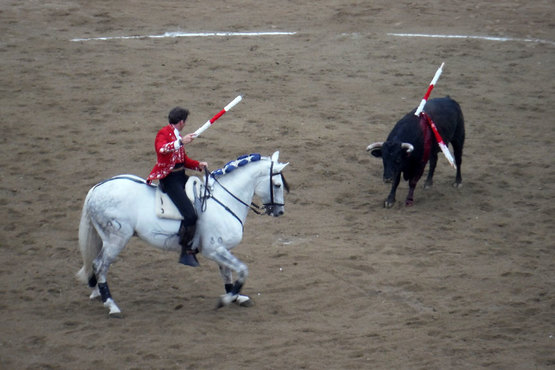
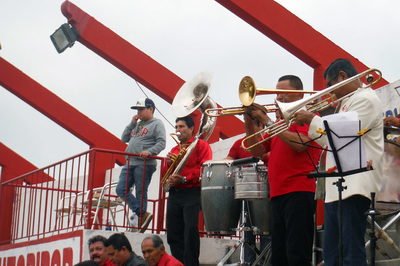
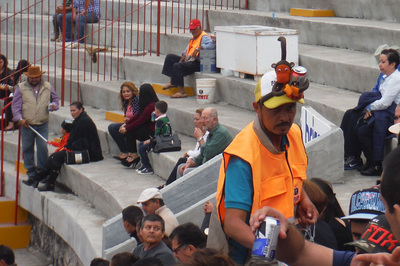
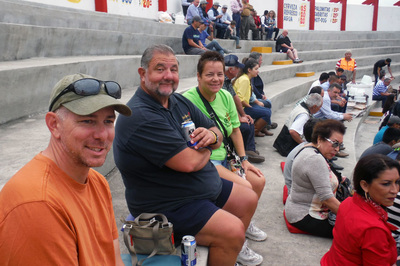
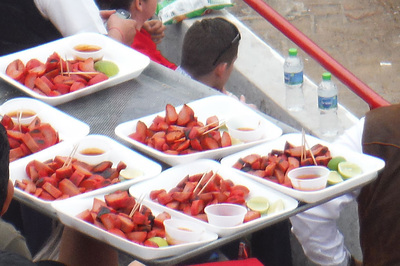
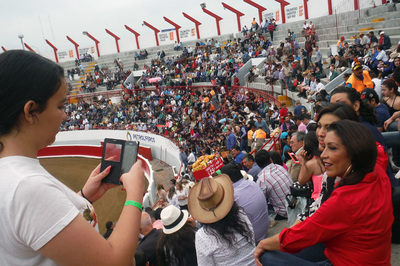
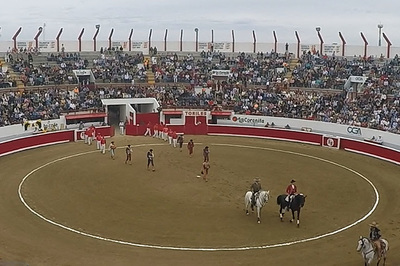
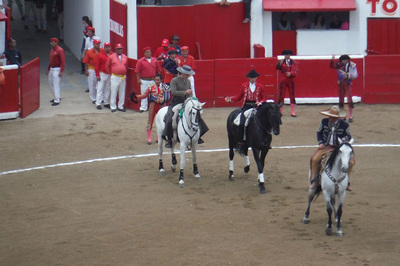
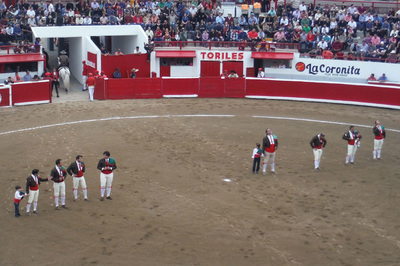
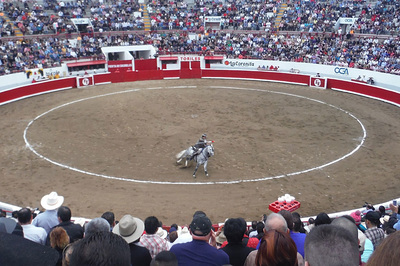
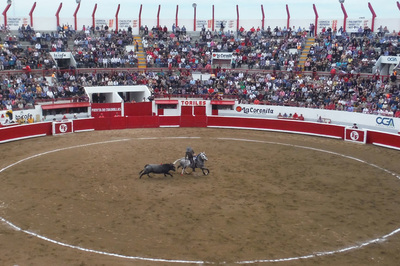
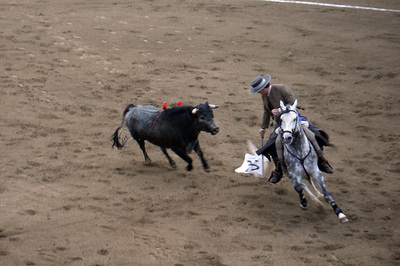
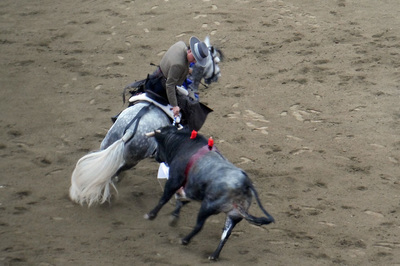
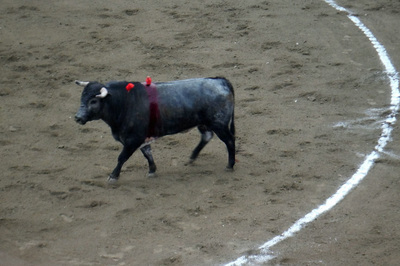
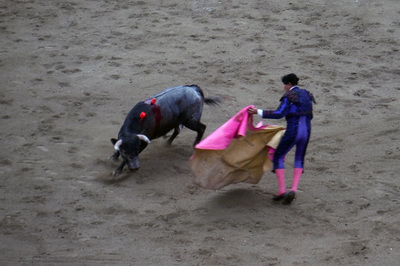
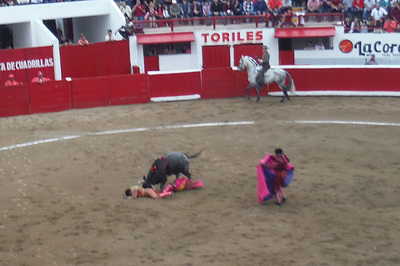
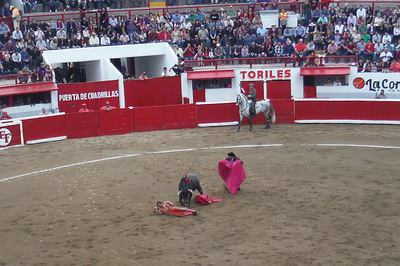
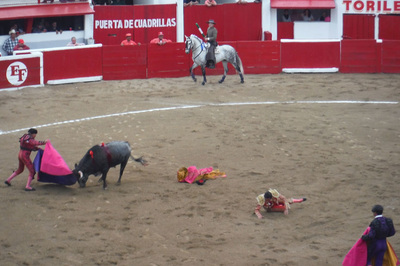
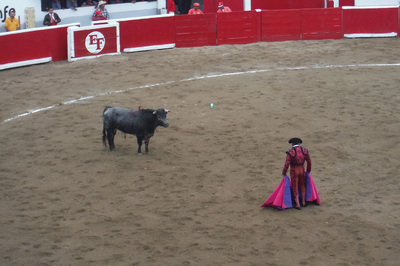
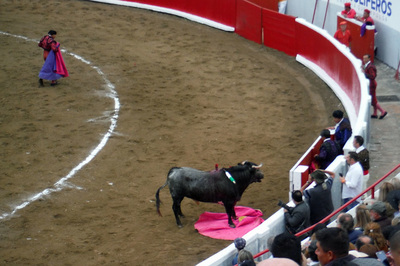
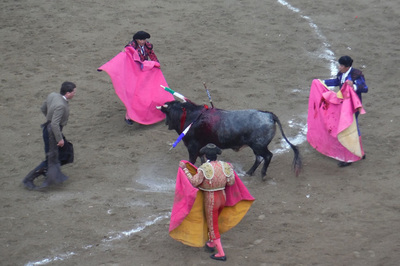
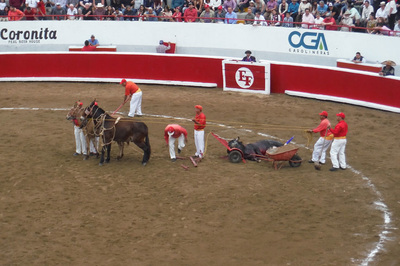
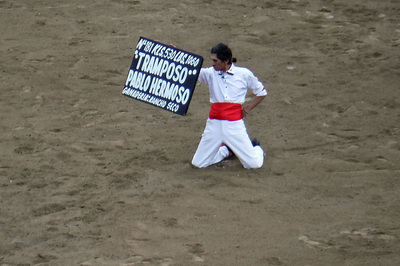
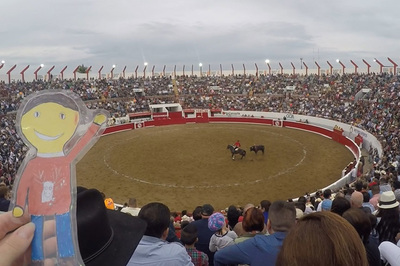
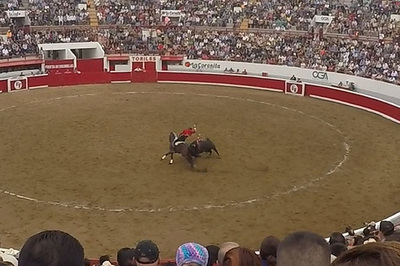
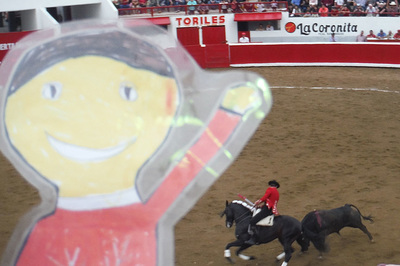
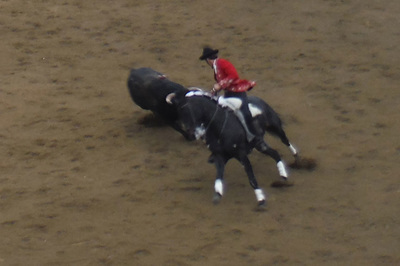
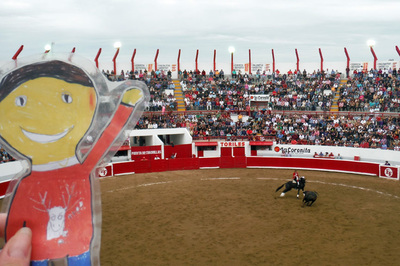
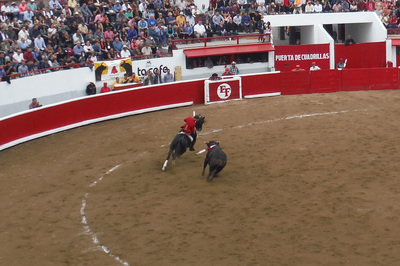
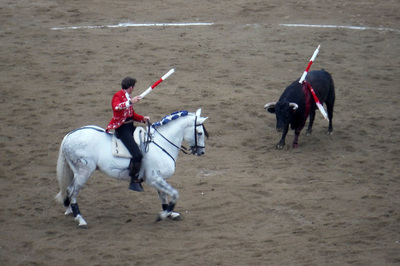
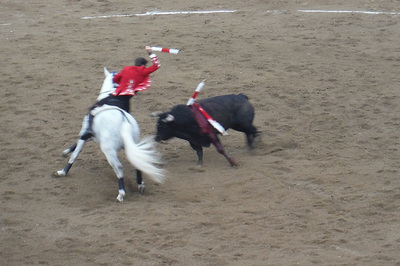
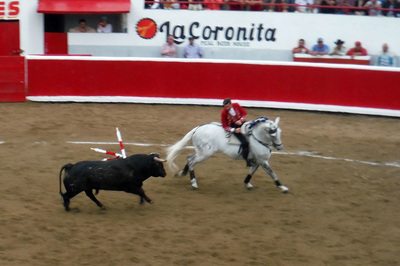
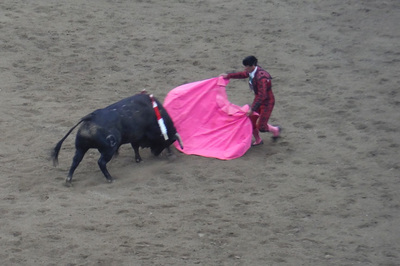
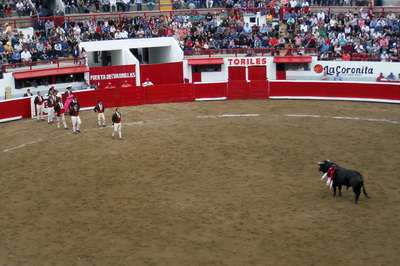
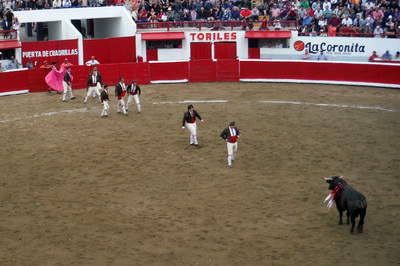
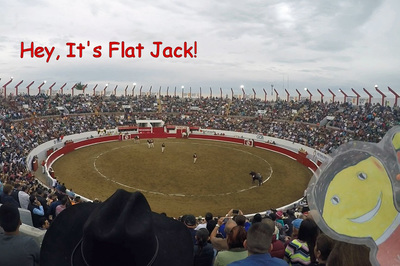
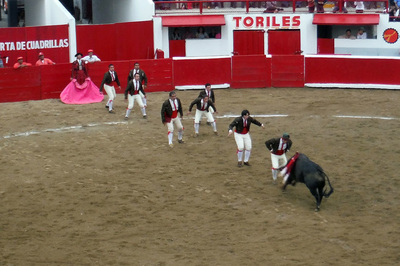
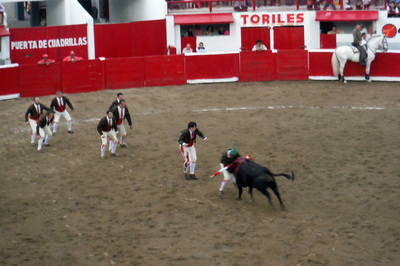
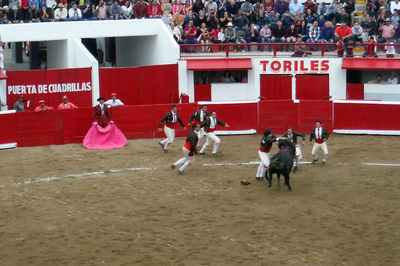
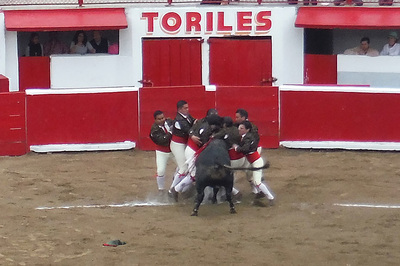
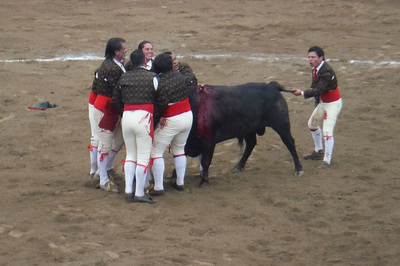
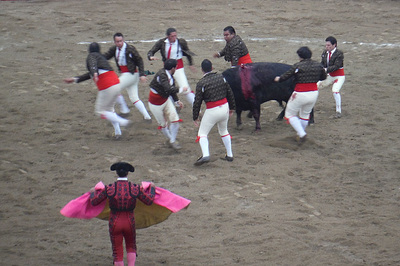
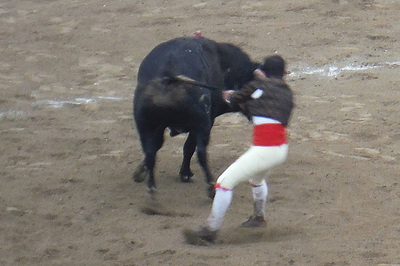
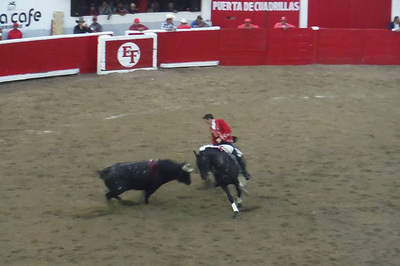
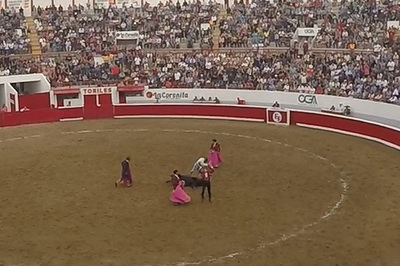
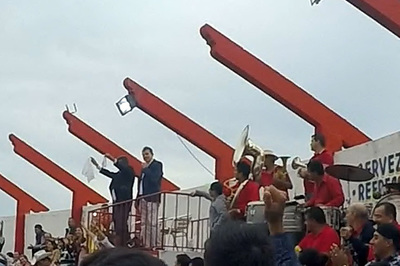
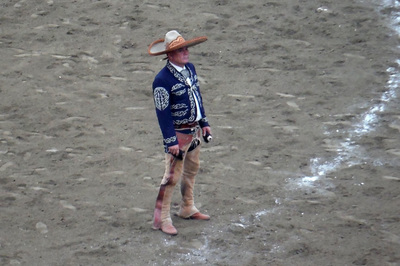
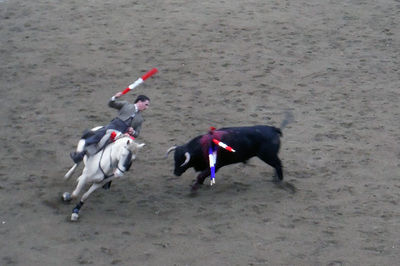
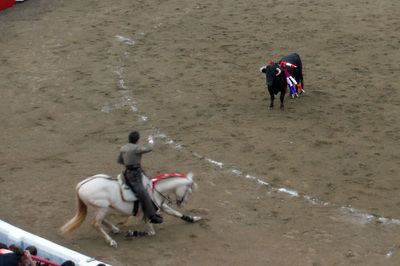
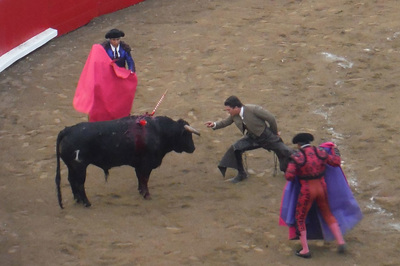
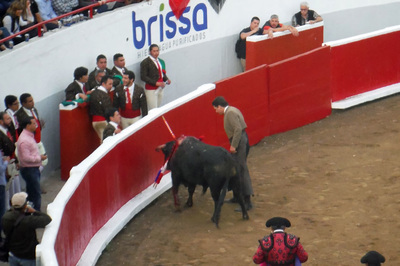
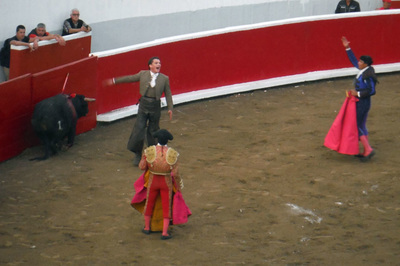
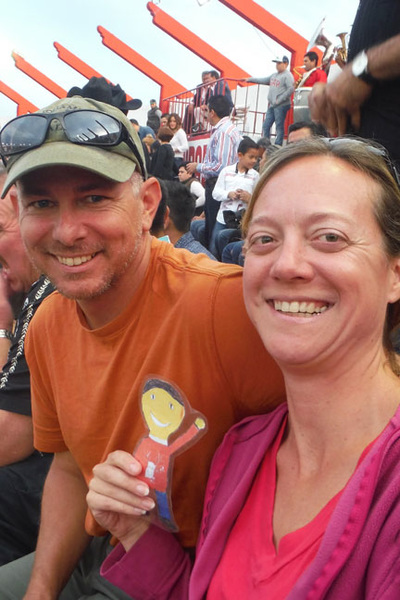
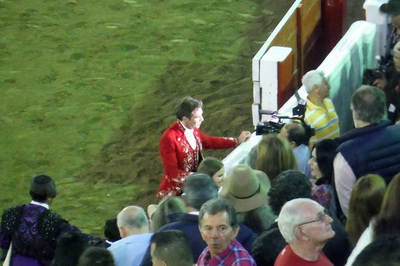
 RSS Feed
RSS Feed
